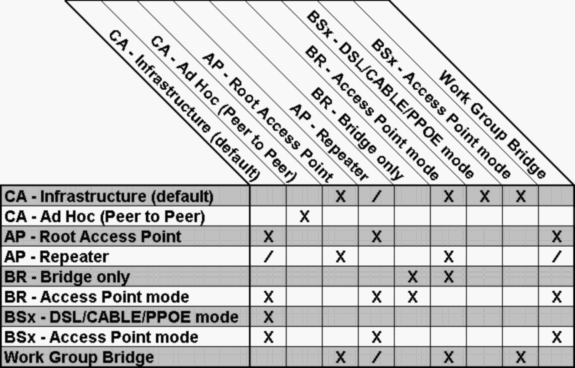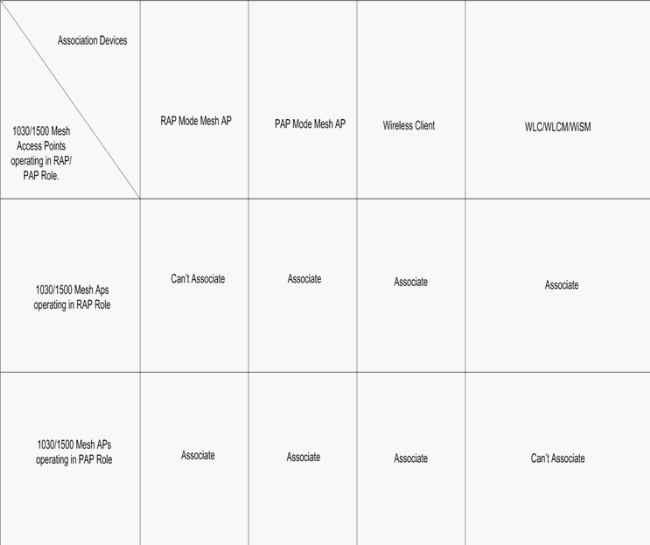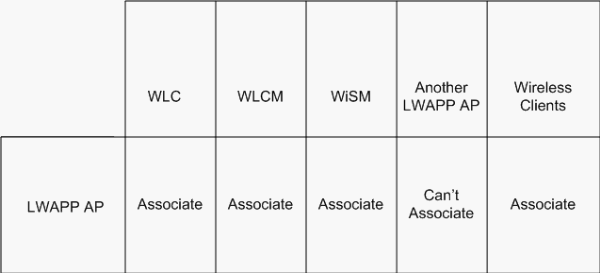Cisco Wireless Devices Association Matrix
Available Languages
Contents
Introduction
When you design or operate a wireless LAN (WLAN), consider the hardware components capacity to form an association with other elements of the network. This document describes in simple format the association capabilities of each Cisco wireless component.
Prerequisites
Requirements
There are no specific requirements for this document.
Components Used
This document is applicable to all Cisco wireless hardware and software versions.
Conventions
Refer to Cisco Technical Tips Conventions for more information on document conventions.
Bridges and Autonomous APs Association Matrix
The 802.11 association process allows an AP to map a logical port or association identifier (AID) to the wireless station. The association process is initiated by the wireless station with an association request frame containing the capability information of the client and completed by the AP in an association response frame. The association response indicates success or failure as well as a reason code.
Use the Matrix
This matrix considers the configurable capabilities of the different Cisco Aironet components. For example, because the Cisco Aironet Client Adapter card can be configured to work in either Infrastructure mode or in Ad Hoc mode, there is a column and row for each mode.
Note: This matrix does not focus on lightweight and mesh devices. There are separate sections in this document, Wireless Mesh Hardware Association and LWAPP APs Association, that discuss association details of these devices.
In order to determine whether two particular Cisco Aironet components can form an association, choose one of the components from the columns across the top of the matrix and choose the other from the rows listed along the left side of the matrix.
If the two components can form an association, there is an X where the selected column and row intersect. A blank space indicates an inability to associate.
Matrix and Legend
CA = Client Adapter AP = Access Point BR = Ethernet Bridge BSx = Base Station X = association possible / = association possible if repeater is associated to "root" AP

Wireless Mesh Hardware Association
The mesh networking solution, which is part of the Cisco Unified Wireless Network Solution, enables two or more Cisco Aironet Lightweight Mesh Access Points (hereafter called mesh APs) to communicate with each other over one or more wireless hops in order to join multiple LANs or to extend 802.11b wireless coverage. Cisco Mesh APs are configured, monitored, and operated from and through any Cisco WLAN controller (WLC) deployed in the mesh networking solution.
Cisco Aironet 1030 Remote Edge Lightweight APs and Cisco Aironet 1500 Series Lightweight Outdoor APs can be deployed as mesh APs.
You can operate the Cisco Aironet 1030 Remote Edge Lightweight APs and Cisco Aironet 1500 Series Lightweight Outdoor APs in one of these roles:
-
Roof-top Access Point (RAP)
-
Pole-top Access Point (PAP)
Mesh Hardware - Association Table
Here is the Association table for the wireless mesh devices:
-
WLCM stands for Wireless LAN Controller Module
-
WiSM stands for Wireless Integrated Services Module

Note: Cisco Aironet 1030 Remote Edge Lightweight APs and Cisco Aironet 1500 Series Lightweight Outdoor APs support single-hop deployments. However, Cisco Aironet 1500 Series Lightweight Outdoor APs are required to support multi-hop backhaul deployments.
Refer to the Cisco Mesh Networking Solution Deployment Guide for more information.
LWAPP APs Association
Lightweight AP Protocol (LWAPP)-enabled APs are part of the Cisco Integrated Wireless Network Solution and require no manual configuration before they are mounted. The AP is configured by an LWAPP-capable Cisco WLC.
In the Cisco Centralized WLAN architecture, LWAPP-enabled APs operate in the lightweight mode (as opposed to the autonomous mode).
LWAPP is an IETF draft protocol that defines the control messaging for setup and path authentication and run-time operations. LWAPP also defines the tunneling mechanism for data traffic.
Here is the Association table for the LWAPP devices:

Note: LWAPP APs do not have any relationship with autonomous APs. LWAPP APs come under centralized WLAN architecture. Whereas, autonomous APs come under distributed WLAN architecture. In addition to LWAPP APs, there are certain APs which can act in both LWAPP mode and autonomous mode (not at the same time) if the appropriate firmware is installed.
Related Information
- Aironet 340 Series Wireless LAN Products
- Aironet 350 Series Wireless LAN Products
- Cisco Software Center for Wireless Products
- LWAPP Upgrade Tool Troubleshoot Tips
- Cisco Aironet 1500 Series Lightweight Outdoor Mesh Access Points
- Cisco Wireless Mesh Networking Solution Overview
- Cisco Aironet 1500 Series - Products & Services
- Lightweight Access Point FAQ
- Technical Support & Documentation - Cisco Systems
Revision History
| Revision | Publish Date | Comments |
|---|---|---|
1.0 |
11-Feb-2002 |
Initial Release |
Contact Cisco
- Open a Support Case

- (Requires a Cisco Service Contract)
 Feedback
Feedback